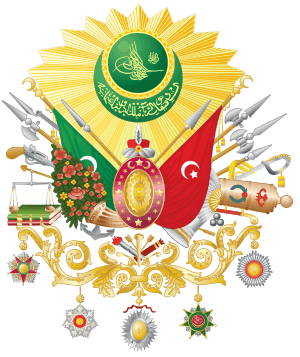Mevhibe Kadın
Mevhibe Kadın (Ottoman Turkish: محبه قادین; 6 August 1835 – 21 February 1936) was the first wife and chief consort of Sultan Murad V of the Ottoman Empire.
| Mevhibe Kadın | |||||
|---|---|---|---|---|---|
| Born | 6 August 1835 Tbilisi, Georgia | ||||
| Died | 21 February 1936 (aged 100) Şişli, Istanbul, Turkey | ||||
| Spouse | |||||
| |||||
| House | Ottoman (by marriage) | ||||
| Father | Ahmed Tarkanişvili | ||||
| Religion | Sunni Islam | ||||
Early Life
Mevhibe Kadın was born on 6 August 1835 in Tbilisi, Georgia. She was a member of a Georgian noble family, Tarkanişvili. Her father was Ahmed Bey Tarkanişvili [1] . Mevhibe had a brother, Halil Bey who was in service in the stable of the palace. Halil Bey's daughter Gülter Hanım was married to her step son, Şehzade Mehmed Selaheddin. She was tall, buxom and had beautiful hazel eyes. At a very young age she was given in service to the palace. [2][3]
Marriage
Mevhibe married Murad, when he was still a prince on 2 January 1857, when she was twenty-one years old and Murad was sixteen years old. [1][3][4] After the succession of Murad to the throne on 30 May 1876, she got the title of "Senior Consort" everyone thought this most unusual, because Mevhibe had not given birth to any children whatsoever, and in the imperial practice and convention it was not the custom for a childless wife to hold the rank of Kadın. Murad demonstrated another unusual behavior in this matter a well. He simply insisted that this old love of his, with whom he had grown up since they were both young and who had entered the ranks of his wives when he was still a prince, should become his Baş Kadın. [3]
After the abduction of her husband from the throne she and Murad's family were imprisoned in the Çırağan Palace, where she lived until death of Murad in 1904. She wore European dresses and used to stay in the palace garden for long time. [5]
Character
Nonetheless, it was certainly true that Mevhibe possessed the talents and skills necessary to occupy the post of Senior Consort. First of all she was extremely beautiful. Beneath her incomparably graceful black eyebrows, her flashing kohl-tingled black eyes lent an irresistible enchantment to her clear white face warmed with a touch of gentle pink whenever she spoke. She was highly intelligent and perceptive. Anyone who met her or spoke with her could not help but fall under her bewitching spell. And she had long reconciled herself to her lot; throughout their imprisonment in the Çırağan Palace, she remained completely loyal to her husband. [6]
Death
After Murad's death and proclamation of the Constitution, she purchased a home in Şişli and retreated there to live a life of seclusion. At the exile of imperial family in 1924, she stayed in Istanbul. She died on 21 February 1936 at the age of 100 and she was the longest living Ottoman consorts. [5][7][4]
References
- Adra, Jamil (2005). Genealogy of the Imperial Ottoman Family 2005. p. 19.
- Açba 2007, p. 98.
- Sakaoğlu 2008, p. 649.
- Uluçay 2011, p. 237.
- Açba 2007, p. 99.
- Brookes 2010, p. 37.
- Sakaoğlu 2008, p. 650.
Sources
- Uluçay, M. Çağatay (2011). Padişahların kadınları ve kızları. Ötüken. ISBN 978-9-754-37840-5.
- Açba, Harun (2007). Kadın efendiler: 1839-1924. Profil. ISBN 978-9-759-96109-1.
- Sakaoğlu, Necdet (2008). Bu Mülkün Kadın Sultanları: Vâlide Sultanlar, Hâtunlar, Hasekiler, Kandınefendiler, Sultanefendiler. Oğlak Yayıncılık. ISBN 978-6-051-71079-2.
- The Concubine, the Princess, and the Teacher: Voices from the Ottoman Harem. University of Texas Press. 2010. ISBN 978-0-292-78335-5.
